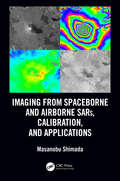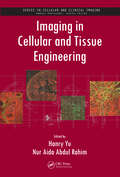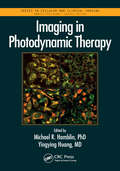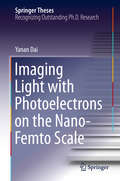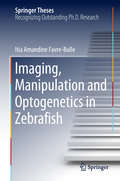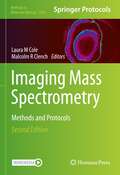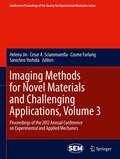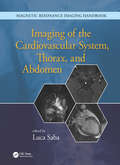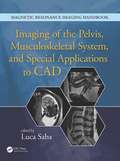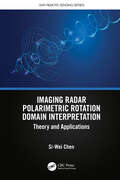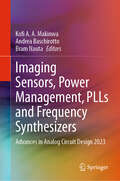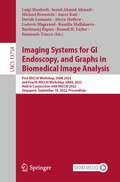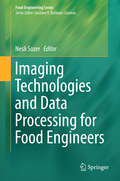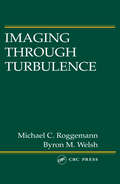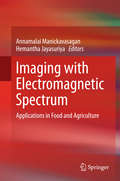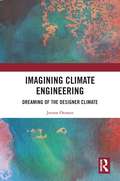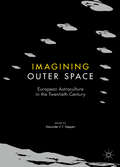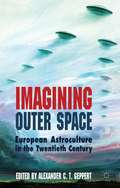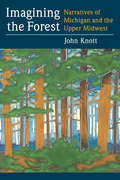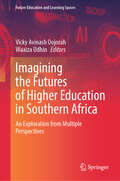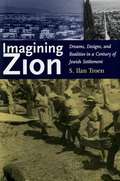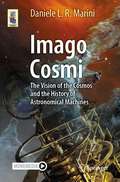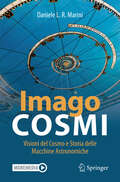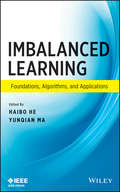- Table View
- List View
Imaging from Spaceborne and Airborne SARs, Calibration, and Applications (SAR Remote Sensing)
by Masanobu ShimadaSixty years after its birth, Synthetic Aperture Radar (SAR) evolved as a key player of earth observation, and it is continually upgraded by enhanced hardware functionality and improved overall performance in response to user requirements. The basic information gained by SAR includes the backscattering coefficient of targets, their phases (the truncated distance between SAR and its targets), and their polarization dependence. The spatiotemporal combination of the multiple data operated on the satellite or aircraft significantly increases its sensitivity to detect changes on earth, including temporal variations of the planet in amplitude and the interferometric change for monitoring disasters; deformations caused by earthquakes, volcanic activity, and landslides; environmental changes; ship detection; and so on. Earth-orbiting satellites with the appropriate sensors can detect environmental changes because of their large spatial coverage and availability. Imaging from Spaceborne and Airborne SARs, Calibration, and Applications provides A-to-Z information regarding SAR researches through 15 chapters that focus on the JAXA L-band SAR, including hardware description, principles of SAR imaging, theoretical description of SAR imaging and error, ScanSAR imaging, polarimetric calibration, inflight antenna pattern, SAR geometry and ortho rectification, SAR calibration, defocusing for moving targets, large-scale SAR imaging and mosaic, interferometric SAR processing, irregularities, application, and forest estimation. Sample data are created by using L-band SAR, JERS-1, PALSAR, PALSAR-2, and Pi-SAR-L2. This book is based on the author’s experience as a principal researcher at JAXA with responsibilities for L-band SAR operation and researches. It reveals the inside of SAR processing and application researches performed at JAXA, which makes this book a valuable reference for a wide range of SAR researchers, professionals, and students.
Imaging in Cellular and Tissue Engineering
by Hanry Yu Nur Aida Abdul RahimDetails on specific imaging modalities for different cellular and tissue engineering applications are scattered throughout articles and chapters in the literature. Gathering this information into a single reference, Imaging in Cellular and Tissue Engineering presents both the fundamentals and state of the art in imaging methods, approaches, and app
Imaging in Photodynamic Therapy (Series in Cellular and Clinical Imaging)
by Michael R. Hamblin Yingying HuangThis book covers the broad field of cellular, molecular, preclinical, and clinical imaging either associated with or combined with photodynamic therapy (PDT). It showcases how this approach is used clinically for cancer, infections, and diseases characterized by unwanted tissue such as atherosclerosis or blindness. Because the photosensitizers are also fluorescent, the book also addresses various imaging systems such as confocal microscopy and small animal imaging systems, and highlights how they have been used to follow and optimize treatment, and to answer important mechanistic questions. Chapters also discuss how imaging has made important contributions to clinical outcomes in skin, bladder, and brain cancers, as well as in the development of theranostic agents for detection and treatment of disease. This book provides a resource for physicians and research scientists in cell biology, microscopy, optics, molecular imaging, oncology, and drug discovery.
Imaging Light with Photoelectrons on the Nano-Femto Scale (Springer Theses)
by Yanan DaiThis thesis presents significant advances in the imaging and theory of the ultrafast dynamics of surface plasmon polariton fields. The author details construction of a sub-10 femtosecond and sub-10 nanometer spatiotemporal resolution ultrafast photoemission microscope which is subsequently used for the discovery of topological meron and skyrmion-like plasmonic quasiparticles. In particular, this enabled the creation of movies of the surface plasmon polariton fields evolving on sub-optical wavelength scales at around 0.1 femtosecond per image frame undergoing vortex phase evolution. The key insight that the transverse spin of surface plasmon polaritons undergoes a texturing into meron or skyrmion-like topological quasiparticles (defined by the geometric charge of the preparation) follows. In addition, this thesis develops an analytical theory of these new topological quasiparticles, opening new avenues of research, while the ultrafast microscopy techniques established within will also be broadly applicable to studies of nanoscale optical excitations in electronic materials.
Imaging, Manipulation and Optogenetics in Zebrafish (Springer Theses)
by Itia Amandine Favre‐BulleThe work described here investigates the advantages and limitations of using laser light for the deep in-vivo illumination and micromanipulation of the neuronal system in zebrafish. To do so, it combines and develops novel optical methods such as optogenetics, light sheet microscopy and optical micromanipulation. It also demonstrates, for the first time, that directional and focused laser beams can successfully be used to target large objects at considerable depth in a living organism to exert purely optical force – in this case on otoliths (ear stones) – and create fictive vestibular stimuli in a stationary animal. The behavioural study and simultaneous imaging of the whole brain reveal the location of the brain cells specific to each ear stone. Elucidating these fundamental neural processes holds substantial value for basic neuroscience researchers, who still have only a vague grasp of how brain circuits mediate perception. As such, it represents highly innovative research that has already led to high-impact publications and is now being intensively pursued.
Imaging Mass Spectrometry: Methods and Protocols (Methods in Molecular Biology #2688)
by Laura M Cole Malcolm R ClenchThis second edition details new and updated chapters on key methodologies and breakthroughs in the mass spectrometry imaging (MSI) field. Chapters guide readers through nano-Desorption Electrospray Ionisation (nDESI), Matrix Assisted Laser Desorption Ionisation-2 (MALDI-2), Laser Ablation - Inductively Coupled Plasma-Mass Spectrometry (LA-ICP-MS) ,Imaging Mass Cytometry (IMC) with a variety of diverse samples including eye tissue, crop analysis, 3D cell culture models, and counterfeit goods analysis. Written in the format of the highly successful Methods in Molecular Biology series, each chapter includes an introduction to the topic, lists necessary materials and reagents, includes tips on troubleshooting and known pitfalls, and step-by-step, readily reproducible protocols. Authoritative and cutting-edge, Imaging Mass Spectrometry: Methods and Protocols, Second Edition aims to be a useful and practical guide to new researchers and experts looking to expand their knowledge.
Imaging Methods for Novel Materials and Challenging Applications, Volume 3
by Cosme Furlong Helena Jin Sanichiro Yoshida Cesar SciammarellaImaging Methods for Novel Materials and Challenging Applications, Volume 3: Proceedings of the 2012 Annual Conference on Experimental and Applied Mechanics, the third volume of seven from the Conference, brings together 62 contributions to this important area of research and engineering. The collection presents early findings and case studies on fundamental and applied aspects of Experimental and Applied Mechanics, including papers on: Role of optical interferometry in advancement of material characterizationThree-dimensional imaging and volumetric correlationDigital holography and experimental mechanicsDigital image correlationMetrology and displacement measurement at different scalesOptical methods for dynamic testsOptical methods for and with MEMS and NEMSThermomechanics and infrared imagingImaging methods applied to biomaterials and soft materialsApplied photoelasticityOptical measurement systems using polarized lightHybrid imaging techniquesContouring of surfacesNovel optical techniques
Imaging of the Cardiovascular System, Thorax, and Abdomen
by Luca SabaMagnetic resonance imaging (MRI) is a technique used in biomedical imaging and radiology to visualize internal structures of the body. Because MRI provides excellent contrast between different soft tissues, the technique is especially useful for diagnostic imaging of the brain, muscles, and heart. <P><P>In the past 20 years, MRI technology has improved significantly with the introduction of systems up to 7 Tesla (7 T) and with the development of numerous post-processing algorithms such as diffusion tensor imaging (DTI), functional MRI (fMRI), and spectroscopic imaging. From these developments, the diagnostic potentialities of MRI have improved impressively with an exceptional spatial resolution and the possibility of analyzing the morphology and function of several kinds of pathology. <P><P>Given these exciting developments, the Magnetic Resonance Imaging Handbook: Imaging of the Cardiovascular System, Thorax, and Abdomen is a timely addition to the growing body of literature in the field. Offering comprehensive coverage of cutting-edge imaging modalities, this book: <Li>Discusses MRI of the heart, blood vessels, lungs, breasts, diaphragm, liver, gallbladder, spleen, pancreas, adrenal glands, and gastrointestinal tract <Li>Explains how MRI can be used in vascular, posttraumatic, postsurgical, and computer-aided diagnostic (CAD) applications <Li>Highlights each organ’s anatomy and pathological processes with high-quality images <Li>Examines the protocols and potentialities of advanced MRI scanners such as 7 T systems <Li>Includes extensive references at the end of each chapter to enhance further study <P><P>Thus, the Magnetic Resonance Imaging Handbook: Imaging of the Cardiovascular System, Thorax, and Abdomen provides radiologists and imaging specialists with a valuable, state-of-the-art reference on MRI.
Imaging of the Pelvis, Musculoskeletal System, and Special Applications to CAD
by Luca SabaMagnetic resonance imaging (MRI) is a technique used in biomedical imaging and radiology to visualize internal structures of the body. Because MRI provides excellent contrast between different soft tissues, the technique is especially useful for diagnostic imaging of the brain, muscles, and heart.In the past 20 years, MRI technology has improved si
Imaging Radar Polarimetric Rotation Domain Interpretation: Theory and Applications (SAR Remote Sensing)
by Si-Wei ChenPolarimetric rotation domain interpretation is an innovation in radar image processing and understanding. Orientation rotation is a basic operator well known in the classic polarimetry theory, and significant advancement has been made in recent years. This book presents new and advanced concepts, theories, and methodologies in radar polarimetry and bridges the gaps between target scattering diversity, polarimetric radar data, and their practical applications. It provides a comprehensive summarization and investigation of polarimetric rotation domain features and demonstrates novel applications of polarimetric radar target detection, classification, target structure recognition, and urban damage mapping.FEATURES Focuses on basic concepts, key techniques, and various applications of the polarimetric rotation domain interpretation paradigm for the first time in book form Explains, represents, and utilizes the radar target scattering diversity effect Identifies new methods for target polarimetric scattering mechanism understanding Provides a comprehensive investigation of polarimetric roll-invariant features Includes novel application developments for imaging radar target detection, structure recognition, and damage mapping This book is written for researchers and professionals in radar polarimetry, radar imaging, microwave remote sensing, environmental studies, and other related fields. Senior undergraduate and postgraduate students, as well as teachers in the same fields, will benefit from the advancements highlighted in this book.
Imaging Sensors, Power Management, PLLs and Frequency Synthesizers: Advances in Analog Circuit Design 2023
by Kofi A. A. Makinwa Andrea Baschirotto Bram NautaThis book is based on the 18 tutorials presented during the 31st workshop on Advances in Analog Circuit Design held in Villach, Austria. In it, expert designers share their insights on a variety of topics at the frontier of analog circuit design, with specific contributions focusing on the design of imaging sensors, power management circuits, PLLs and frequency synthesizers. As such, for anyone involved in analog circuit research and development, this book provides a valuable overview of the state-of-the-art.
Imaging Systems for GI Endoscopy, and Graphs in Biomedical Image Analysis: First MICCAI Workshop, ISGIE 2022, and Fourth MICCAI Workshop, GRAIL 2022, Held in Conjunction with MICCAI 2022, Singapore, September 18, 2022, Proceedings (Lecture Notes in Computer Science #13754)
by Luigi Manfredi Seyed-Ahmad Ahmadi Michael Bronstein Anees Kazi Davide Lomanto Alwyn Mathew Ludovic Magerand Kamilia Mullakaeva Bartlomiej Papiez Russell H. Taylor Emanuele TruccoThis book constitutes the refereed proceedings of the first MICCAI Workshop, ISGIE 2022, Imaging Systems for GI Endoscopy, and the Fourth MICCAI Workshop, GRAIL 2022, GRaphs in biomedicAL Image and analysis, held in conjunction with MICCAI 2022, Singapore, September 18, 2022.ISGIE 2022 accepted 6 papers from the 8 submissions received.This workshop focuses on novel scientific contributions to vision systems, imaging algorithms as well as the autonomous system for endorobot for GI endoscopy. This includes lesion and lumen detection, as well as 3D reconstruction of the GI tract and hand-eye coordination. GRAIL 2022 accepted 6 papers from the 10 submissions received. The workshop aims to bring together scientists that use and develop graph-based models for the analysis of biomedical images and to encourage the exploration of graph-based models for difficult clinical problems within a variety of biomedical imaging contexts.
Imaging Technologies and Data Processing for Food Engineers
by Nesli SozerFood products are complex in nature which makes their analysis difficult. Different scientific disciplines such as biochemistry, microbiology, and nutrition, together with engineering concepts are involved in their characterization. However, imaging of food materials and data analysis has gained more importance due to innovations in the food industry, as well as the emergence of food nanotechnology. Image analysis protocols and techniques can be used in food structure analysis and process monitoring. Therefore, food structure imaging is crucial for various sections of the food chain starting from the raw material to the end product. This book provides information on imaging techniques such as electron microscopy, laser microscopy, x-ray tomography, raman and infrared imaging, together with data analysis protocols. It addresses the most recent advances in imaging technologies and data analysis of grains, liquid food systems (i. e. emulsions and gels), semi-solid and solid foams (i. e. bakery products, dough, expanded snacks), protein films, fruits and vegetable confectionery and nuts. This book also: Provides in-depth view of raw material characterization and process control Covers structure-functionality and structure-texture relationships Reviews applications to emerging areas of food science with an insight into future trends
Imaging the Brain with Optical Methods
by Anna W. RoeThe technology of detecting and interpreting patterns of reflected light has reached a remarkable degree of maturity that now permits high spatial and temporal resolution visualization at both the systems and cellular levels. There now exist several optical imaging methodologies, based on either hemodynamic changes in nervous tissue or neurally-induced light scattering changes, that can be used to measure ongoing activity in the brain. In two parts, Imaging the Brain with Optical Methods discusses the history of optical imaging and its use in the study of brain function, and the rapidly developing optical technologies and their applications that have recently developed. These include intrinsic signal optical imaging, near-infrared optical imaging, fast optical imaging based on scattered light, optical imaging with voltage sensitive dyes, and 2 photon imaging of hemodynamic signals. In total, this volume will encapsulate the current state of optical imaging methodologies and their contribution towards understanding the spatial and temporal organization of cerebral cortical function.
Imaging Through Turbulence
by Michael C. Roggemann Byron M. WelshLearn how to overcome resolution limitations caused by atmospheric turbulence in Imaging Through Turbulence. This hands-on book thoroughly discusses the nature of turbulence effects on optical imaging systems, techniques used to overcome these effects, performance analysis methods, and representative examples of performance. Neatly pulling together widely scattered material, it covers Fourier and statistical optics, turbulence effects on imaging systems, simulation of turbulence effects and correction techniques, speckle imaging, adaptive optics, and hybrid imaging. Imaging Through Turbulence is written in tutorial style, logically guiding you through these essential topics. It helps you bring down to earth the complexities of coping with turbulence.
Imaging with Electromagnetic Spectrum
by Annamalai Manickavasagan Hemantha JayasuriyaThis book demonstrates how imaging techniques, applying different frequency bands from the electromagnetic spectrum, are used in scientific research. Illustrated with numerous examples this book is structured according to the different radiation bands: From Gamma-rays over UV and IR to radio frequencies. In order to ensure a clear understanding of the processing methodologies, the text is enriched with descriptions of how digital images are formed, acquired, processed and how to extract information from them. A special emphasis is given to the application of imaging techniques in food and agriculture research.
Imagining Climate Engineering: Dreaming of the Designer Climate
by Jeroen OomenThis book highlights the increasing attention for climate engineering, a set of speculative technologies aimed to counter global warming. What is the future of the global climate? And who gets to decide—or even design—this future? Imagining Climate Engineering explores how and why climate engineering became a potential approach to anthropogenic climate change. Specifically, it showcases how views on the future of climate change and climate engineering evolved by addressing the ways in which climate engineers view its respective physical, political, and moral domains. Tracing the intellectual and political history of dreams to control the weather and climate as well as the discovery of climate change, Jeroen Oomen examines the imaginative parameters within which contemporary climate engineering research takes place. Introducing the analytical metaphor ‘ways of seeing’ to describe explicit or implicit visions, understandings, and foci that facilitate a particular understanding of what is at stake, Imagining Climate Engineering shows how visions on the knowability of climate tie into moral and political convictions about the possibility and desirability of engineering the climate. Marrying science and technology studies and the environmental humanities, Oomen provides crucial insights for the future of the climate change debate for scholars and students.
Imagining Outer Space: European Astroculture In The Twentieth Century (Palgrave Studies in the History of Science and Technology)
by Alexander C.T. GeppertImagining Outer Space makes a captivating advance into the cultural history of outer space and extraterrestrial life in the European imagination. How was outer space conceived and communicated? What promises of interplanetary expansion and cosmic colonization propelled the project of human spaceflight to the forefront of twentieth-century modernity? In what way has West-European astroculture been affected by the continuous exploration of outer space? Tracing the thriving interest in spatiality to early attempts at exploring imaginary worlds beyond our own, the book analyzes contact points between science and fiction from a transdisciplinary perspective and examines sites and situations where utopian images and futuristic technologies contributed to the omnipresence of fantasmatic thought. Bringing together state-of-the-art work in this emerging field of historical research, the volume breaks new ground in the historicization of the Space Age.
Imagining Outer Space
by Alexander C. T. GeppertImagining Outer Space makes a captivating advance into the cultural history of outer space and extraterrestrial life in the European imagination. How was outer space conceived and communicated? What promises of interplanetary expansion and cosmic colonization propelled the project of human spaceflight to the forefront of twentieth-century modernity? In what way has West-European astroculture been affected by the continuous exploration of outer space? Tracing the current thriving interest in spatiality to early attempts at exploring imaginary worlds beyond our own, the book's authors analyze contact points between science and fiction from a transdisciplinary perspective and examine sites and situations where utopian images and futuristic technologies contributed to the omnipresence of fantasmatic thought. Bringing together state-of-the-art work in this emerging field of historical research, thevolumebreaks new ground in the historicization of the Space Age. "
Imagining the Forest // Narratives of Michigan and the Upper Midwest
by John Knott"Forests have always been more than just their trees. The forests in Michigan (and similar forests in other Great Lakes states such as Wisconsin and Minnesota) played a role in the American cultural imagination from the beginnings of European settlement in the early 19th century to the present. Our relationships with those forests have been shaped by the cultural attitudes of the times, and people have invested in them both moral and spiritual meanings. Author John Knott draws upon such works as Simon Schama's Landscape and Memory and Robert Pogue Harrison's Forests: The Shadow of Civilization in exploring ways in which our relationships with forests have been shaped, using Michigan-its history of settlement, popular literature, and forest management controversies-as an exemplary case. Knott looks at such well-known figures as William Bradford, James Fenimore Cooper, John Muir, John Burroughs, and Teddy Roosevelt; Ojibwa conceptions of the forest and natural world (including how Longfellow mythologized them); early explorer accounts; and contemporary literature set in the Upper Peninsula, including Jim Harrison's True North and Philip Caputo's Indian Country. Two competing metaphors evolved over time, Knott shows: the forest as howling wilderness, impeding the progress of civilization and in need of subjugation, and the forest as temple or cathedral, worthy of reverence and protection. Imagining the Forest shows the origin and development of both"--
Imagining the Futures of Higher Education in Southern Africa: An Exploration from Multiple Perspectives (Future Education and Learning Spaces)
by Waaiza Udhin Vicky Avinash OojorahThis book showcases multiple perspectives about the futures of Higher Education from experts and other stakeholders in academia in the Southern African region, with each chapter presenting a different scenario of a possible future for Higher Education. It situates itself at the confluence of various fields of study such as Educational Technologies, Artificial Intelligence (AI), Sociology of Education, Sociology of the Future, Sustainable Development and Climate Change. It also includes various topics, such as digital development in terms of AI and emerging technologies, Higher Educational strategising and planning, the philosophical underpinnings of Higher Education and the present-day need for Sustainable Development models. Through the various chapters discussing the above-mentioned themes in the varied contexts of the Southern African region, this book helps readers engage in imaginative thinking regarding the future world and thus be prepared to embrace the challenges ahead. This book also underpins curriculum development for the new era firstly through new philosophical outlooks and secondly through ideas for novel learning areas in Higher Education and content to help shape minds for the twenty-first century. This book paves the way for innovation, progress and adaptation to the changing needs of the Higher Education clientele. It also attempts to influence policymaking, support advocates for sustainability and environmental education, prepare for technological advancements and improve the resilience and wellbeing of people in the region.
Imagining Zion: Dreams, Designs, and Realities in a Century of Jewish Settlement
by S. Ilan TroenThis timely book tells the fascinating story of how Zionists colonizers planned and established nearly 700 agricultural settlements, towns, and cities from the 1880s to the present. This extraordinary activity of planners, architects, social scientists, military personnel, politicians, and settlers is inextricably linked to multiple contexts: Jewish and Zionist history, the Arab/Jewish conflict, and the diffusion of European ideas to non-European worlds. S. Ilan Troen demonstrates how professionals and settlers continually innovated plans for both rural and urban frontiers in response to the competing demands of social and political ideologies and the need to achieve productivity, economic independence, and security in a hostile environment. In the 1930s, security became the primary challenge, shaping and even distorting patterns of growth. Not until the 1993 Oslo Accords, with prospects of compromise and accommodation, did planners again imagine Israel as a normal state, developing like other modern societies. Troen concludes that if Palestinian Arabs become reconciled to a Jewish state, Israel will reassign priority to the social and economic development of the country and region.
Imago Cosmi: The Vision of the Cosmos and the History of Astronomical Machines (Astronomers' Universe)
by Daniele L. MariniThis book takes the reader on an exploration of the Cosmos, from Mesopotamia and Egypt to China; it unveils the fascinating development of astronomy and mathematics. After an overview of the origins of these subjects, highlighting the contributions of Greek astronomers, the Arab culture, and Copernicus' solar system model, the book delves into the revolutionary work of Tycho Brahe, Johannes Kepler, Galileo Galilei, and Isaac Newton, leading to a comprehensive understanding of the solar system. Special attention is given to the instruments used by ancient astronomers, including the most important astronomical clocks and planetary machines. In light of this, the author examines Kepler's almost unknown design of a planetary machine and offers an interpretation using virtual reality techniques. The book also highlights the Chinese view of the Cosmos and the evolution of its astronomy and astronomical machines, offering readers a unique perspective and insight into the relationship between astronomy and technology in different cultures. Finally, the author provides a practical approach to understanding the construction and mechanics of astronomical machines, exploring the process of designing and manufacturing a Tellurium. The reading is enriched with short videos of the Tellurium, along with a translation of the description of the planetary machine by Christian Huygens. In addition, it provides a unique glimpse into the religious influences on astronomical studies during the mid-1700s through the translation of Johann Albrecht Bengel's book Cyclus. This book is a must-read for anyone interested in the history of science and technology. It appeals to astronomers, mathematicians, physicists, and historians of science and technology alike, providing fascinating descriptions and insightful analysis of the vision of the Cosmos from its earliest conceptions to the present day.
Imago Cosmi: Visioni del Cosmo e Storia delle Macchine Astronomiche
by Daniele L. MariniQuesto libro conduce il lettore in un viaggio esplorativo attraverso il Cosmo, dall'antica Mesopotamia ed Egitto fino alla Cina, svelando il fascino dello sviluppo dell'astronomia e della matematica che ha dato vita alla rivoluzione scientifica. Dopo una panoramica sulle origini di questi campi di studio, evidenziando i contributi degli astronomi greci, della cultura araba e del modello eliocentrico di Copernico, il testo si addentra nel lavoro rivoluzionario di Tycho Brahe, Johannes Kepler, Galileo Galilei e Isaac Newton, offrendo una comprensione approfondita del sistema solare. Gli strumenti utilizzati dagli astronomi, tra cui gli orologi astronomici e le macchine planetarie più significative, sono al centro dell'attenzione, consentendo di comprendere meglio la formazione e la diffusione della concezione del Sistema Solare. Inoltre, l'autore esamina il poco conosciuto progetto di una macchina planetaria di Kepler e ne offre un'interpretazione utilizzando tecniche di realtà virtuale. Il libro mette in luce anche la visione cinese del Cosmo e l'evoluzione della sua astronomia e delle relative macchine, offrendo ai lettori una prospettiva unitaria sulla concezione del cosmo e della tecnologia in Occidente e nell'Estremo Oriente. I dati degli ingranaggi e dei periodi planetari delle macchine esaminate nel testo sono raccolti tra gli annessi web del libo. L'esperienza di lettura è arricchita dalla traduzione della descrizione della macchina planetaria di Christian Huygens e dalla trattazione del progetto e della realizzazione di un Tellurium per comprendere la costruzione e la meccanica delle macchine astronomiche. Inoltre, viene offerta una visione unica sulle influenze religiose sugli studi astronomici del XVIII secolo attraverso la traduzione del libro Cyclus di Johann Albrecht Bengel. Breve materiale video sull'Antikythera, sul Tellurium dell'autore e su quello di Philip M. Hahn completa la documentazione. Questo libro è un must per chiunque sia interessato alla storia della scienza e della tecnologia, appassionando sia gli astronomi, i matematici e i fisici che gli storici della scienza e della tecnologia, fornendo descrizioni affascinanti e analisi illuminanti della visione del Cosmo dalle sue prime concezioni fino ai giorni nostri. Video e documenti disponibili tramite app: scarica gratuitamente l'app SN More Media, scansiona il link con il tasto play e accedi ai video e ai documenti direttamente sul tuo smartphone o tablet.
Imbalanced Learning: Foundations, Algorithms, and Applications
by Haibo He Yunqian MaThe first book of its kind to review the current status and future direction of the exciting new branch of machine learning/data mining called imbalanced learning Imbalanced learning focuses on how an intelligent system can learn when it is provided with imbalanced data. Solving imbalanced learning problems is critical in numerous data-intensive networked systems, including surveillance, security, Internet, finance, biomedical, defense, and more. Due to the inherent complex characteristics of imbalanced data sets, learning from such data requires new understandings, principles, algorithms, and tools to transform vast amounts of raw data efficiently into information and knowledge representation. The first comprehensive look at this new branch of machine learning, this book offers a critical review of the problem of imbalanced learning, covering the state of the art in techniques, principles, and real-world applications.
